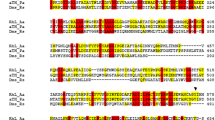Abstract
Crotonobetaine reductase fromEscherichia coli 044 K74 is an inducible enzyme detectable only in cells grown anaerobically in the presence of L(-)-carnitine or crotonobetaine as inducers. Enzyme activity was not detected in cells cultivated in the presence of inducer plus glucose, nitrate, γ-butyrobetaine or oxygen, respectively. Fumarate caused an additional stimulation of growth and an increased expression of crotonobetaine reductase. The reaction product, γ-butyrobetaine, was identified by autoradiography. Crotonobetaine reductase is localized in the cytoplasm, and has been characterized with respect to pH (pH 7.8) and temperature optimum (40–45 °C). The K m value for crotonobetaine was determined to be 1.1×10−2M. γ-Butyrobetaine,D(+)-carnitine and choline are inhibitors of crotonobetaine reduction. For γ-butyrobetaine (K i =3×10−5M) a competitive inhibition type was determined. Various properties suggest that crotonobetaine reductase is different from other reductases of anaerobic respiration.
Similar content being viewed by others
References
Bergmeyer HU (ed) (1970) Methods of Enzymic Analysis, pp 1714–1715, Akademie Verlag, Berlin
Bilous PT & Weiner JH (1985) Dimethyl sulfoxide reductase activity by anaerobically grownEscherichia coli HB 101. J. Bacteriol. 162: 1151–1155
Bradford MM (1976) A rapid and sensitive method for the quantitation of microgram quantities of protein utilizing the principle of protein-dye binding. Anal. Biochem. 72: 248–254
Dickie P & Weiner JH (1979) Purification and characterization of membrane-bound fumarate reductase from anaerobically grownEscherichia coli. Can. J. Biochem. 57: 813–821
Haddock BA & Jones CW (1977) Bacterial respiration. Bacteriol. Rev. 48: 47–99
Ishimoto MS & Shimokawa O (1978) Reduction of trimethylamine N-oxide byEscherichia coli as anaerobic respiration. Z. Allg. Mikrobiol. 18: 173–181
Jung K, Jung H & Kleber H-P (1987) Regulation of L-carnitine metabolism inEscherichia coli. J. Basic. Microbiol. 27: 131–137
Jung H, Jung K & Kleber H-P (1989) Purification and properties of carnitine dehydratase fromEscherichia coli — a new enzyme of carnitine metabolization. Biochim. Biophys. Acta. 1003: 270–276
Jung H, Jung K & Kleber H-P (1990a) L-Carnitine metabolization and osmotic stress response inEscherichia coli. J. Basic. Microbiol. 30: 409–413
Jung H, Jung K & Kleber H-P (1990b) L-Carnitine uptake byEscherichia coli. J. Basic. Microbiol. 30: 507–514
Jung H, Jung K & Kleber H-P (1993) Synthesis of L-carnitine by microorganisms and isolated enzymes. Adv. Biochem. Engin. Biotechnol. 50: 21–44
Kaback HR (1971) Bacterial membranes. Meth. Enzymol. 22: 99–120
Kleber H-P, Seim H, Aurich H & Strack E (1977) Verwertung von Trimethylammoniumverbindungen durchAcinetobacter calcoaceticus. Arch. Microbiol. 112: 201–206
Konings WN & Boonstra J (1977) Anaerobic electron transfer and active transport in bacteria. Curr. Top. Membr. Transp. 9: 177–231
Kröger A (1978) Fumarate as terminal acceptor of phosphorylative electron transport. Biochim. Biophys. Acta 505: 129–145
Myers CR & Myers JM (1992) Fumarate reductase is a soluble enzyme in anaerobically grownShewanella putrefaciens MR-I. FEMS Microbiol. Lett. 98: 13–20
Roth S (1992) Anreicherung und Charakterisierung der Crotonobetainreduktase ausE. coli. Diplomarbeit, Univ. Leipzig
Seim H, Ezold R, Kleber H-P & Strack E (1980) Stoffwechsel des L-Carnitins bei Enterobakterien. Z. Allg. Mikrobiol. 20: 591–594
Seim H, Jung H, Löster H & Kleber H-P (1985) Wachstumsstimulation und Stoffwechsel des Carnitins beiEscherichia coli. Wiss. Z. Karl-Marx-Univ. Leipzig, Math-Nat. R. 34: 287–292
Seim H, Löster H, Claus R, Kleber H-P & Strack E (1982a) Stimulation of the anaerobic growth ofSalmonella typhimurium by reduction of L-carnitine, carnitine derivatives and structure-related trimethylammonium compounds. Arch. Microbiol. 132: 91–95
Seim H, Löster H & Kleber H-P (1982b) Reduktiver Stoffwechsel des L-Carnitins und strukturverwandter Trimethylammoniumverbindungen inEscherichia coli. Acta Biol. Med. Germ. 41: 1009–1018
Shimokawa O & Ishimoto M (1979) Purification and some properties of inducible tertiary amine N-oxide reductase fromEscherichia coli. J. Biochem. 86: 1709–1717
Spencer ME & Guest JR (1973) Isolation and properties of fumarate reductase mutants ofEscherichia coli. J. Bacteriol. 114: 563–570
Violet M, Medani C-L & Giordano G (1985) Trimethylamine N-oxide (TMAO) reductases fromEscherichia coli K-12. FEMS Microbiol. Lett. 27: 85–91
Weiner JH, Rothery RA, Sambasivarao D & Trieber CA (1992) Molecular analysis of dimethylsulfoxide reductase: a complex iron-sulfur molybdoenzyme ofEscherichia coli. Biochim. Biophys. Acta 1102: 1–18
Author information
Authors and Affiliations
Rights and permissions
About this article
Cite this article
Roth, S., Jung, K., Jung, H. et al. Crotonobetaine reductase fromEscherichia coli — a new inducible enzyme of anaerobic metabolization of L(-)-carnitine. Antonie van Leeuwenhoek 65, 63–69 (1994). https://doi.org/10.1007/BF00878280
Received:
Accepted:
Issue Date:
DOI: https://doi.org/10.1007/BF00878280




